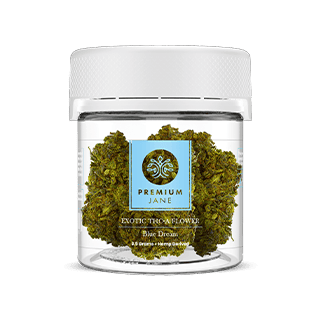Cannabis legalization is sweeping across the states, with an ever-increasing number permitting medical or recreational use. This trend is primarily due to a growing body of evidence regarding the benefits of smoking weed.
Consequently, many now consider cannabis a safer alternative to some prescription medicines. However, smoking weed is not entirely without risk. We explain how to weigh the pros against the cons and decide whether it is right for you.

Want to experience the qualities of THC-A flower? The amazing brand Premium Jane just launched their new line, including strains like OG Kush, Purple Cream, and Blue Dream Pie. Averaging 23% THC-A, there’s so much to love with these flowers. Try them today to get 20% off using WayofLeaf’s exclusive coupon code: THCAWOL
The Endocannabinoid System: How Cannabis Affects the Body
Cannabis exerts its effects by interacting with a physiological network called the endocannabinoid system (ECS). It comprises specialized cell receptors (CB1 and CB2) and chemicals called endocannabinoids. They fit together like a lock and key, producing biochemical signals that help to regulate mood, appetite, pain perception, immunity, and more.
CB1 receptors are prevalent throughout the central nervous system. Meanwhile, CB2 receptors are prevalent throughout the body, particularly in immune cells.
CB1 receptors are significantly influenced by tetrahydrocannabinol (THC), the primary intoxicating compound in cannabis. THC has a similar molecular shape to one of our endocannabinoids, anandamide, allowing it to bind with and activate these receptors.

However, THC binds with CB1 receptors more efficiently than anandamide, strongly stimulating the receptors and producing a mind-altering high.
Other chemicals in cannabis, such as cannabidiol (CBD), also influence these receptors. However, CBD does not bind directly with CB1 receptors in the same way as THC. Instead, it binds indirectly and alters the shape of the receptors so that THC cannot bind as strongly. This is why many people report that CBD can reduce THC’s potency and decrease the risk of side effects.
CBD is also thought to enhance ECS activity by slowing the breakdown of anandamide. Furthermore, it impacts other systems, such as the serotonin system and pathways known as transient receptor potential vanilloid (TRPV) channels. The former affects mood, while the latter regulates inflammation and pain.
Therefore, how cannabis affects the body depends largely on its THC and CBD content, its potency, and how it is used.
Understanding Medical Marijuana and Its Uses
People use cannabis for various reasons, but its potential as a natural remedy is becoming increasingly well-known. Many American states now have medical marijuana programs, granting residents with debilitating conditions legal access to cannabis for medicinal use.
The application process and qualifying conditions vary from state to state. Some states have very restrictive programs, including just a handful of ailments. Others allow physicians to recommend medical cannabis for any patient for whom they believe the benefits of cannabis outweigh the risks.
We explore the most common uses of medical cannabis in the following sections. We will then explain some of the risks associated with smoking weed and how to decide whether it is right for you.
What Are the Medical Benefits of Cannabis?
Research into the therapeutic properties of cannabis has focused on a few core conditions. However, anecdotal reports suggest it may be useful for a broader range of issues. Some of the best-studied areas include the following:
Pain Management
Pain relief is a popular reason to use cannabis. The plant has been used as a painkiller for centuries and is often viewed as a safer alternative to highly addictive prescription drugs like opioids. The ECS influences both inflammation and neurotransmitter release, which could alter how a person experiences pain.
The evidence regarding cannabis and pain is somewhat mixed. A 2020 review concluded that cannabinoids are effective for some types of chronic, but not acute, pain. Its authors stated cannabinoids have “mild beneficial effects for neuropathic pain and may be effective in core orthopedic musculoskeletal pain.” They determined that the quality of the evidence was better for neuropathic pain.
Inflammation
Inflammation is a leading cause of pain and can also contribute to chronic conditions like heart disease, diabetes, and Alzheimer’s disease. Therefore, managing inflammation is crucial to staying healthy and pain-free in later life.
Cannabinoids like THC and CBD are well-known for their anti-inflammatory properties. A 2009 review suggested these compounds could be used as a “potent treatment modality against inflammatory disorders.”
However, it is critical to note that smoking is a pro-inflammatory activity. Therefore, anyone hoping to use cannabis for this purpose should consider alternative consumption methods.
Mental Health
The relationship between weed and mental health is complicated. Many people use it to relax and improve their mood, but sometimes, high doses of THC can cause psychological side effects like anxiety and paranoia.
Therefore, anyone hoping to use cannabis to improve mental health might wish to avoid high-THC strains and choose something with more CBD instead.
There is compelling evidence that CBD can help with anxiety disorders. A 2015 review found that CBD might be helpful for social anxiety disorder, generalized anxiety disorder, and panic disorder. It could also benefit other conditions that feature anxiety as a symptom, such as OCD and PTSD.
Notably, THC-containing cannabis could also help PTSD, and it is often one of the qualifying conditions for medical marijuana. A 2021 review concluded that cannabis could significantly improve PTSD symptoms and quality of life, but the quality of the evidence was low.
Nausea and Vomiting
People also use cannabis to relieve nausea and vomiting, mainly as a side effect of cancer treatments, such as chemotherapy. There is evidence that cannabinoids suppress nausea, and a cannabinoid called nabilone (Cesamet) is licensed to treat chemotherapy-induced nausea and vomiting in the USA.
Nabilone is an analog of THC, meaning it has a similar chemical structure and works in much the same way. Another drug licensed to treat nausea and vomiting is dronabinol (Marinol), a synthetic form of THC.
However, many prefer to use natural cannabis and find that it provides effective relief. There is also evidence that CBD has similar effects and could benefit those who do not have access to legal weed.
Neurological Disorders
There is an association between altered endocannabinoid levels and certain neurological disorders, including Parkinson’s disease, Alzheimer’s disease, Huntington’s disease, and multiple sclerosis. Therefore, many believe that cannabis could help these debilitating conditions.
Although these conditions have diverse etiologies and symptoms, they all cause nervous system damage. And since cannabis affects CB1 receptors in the central nervous system, it seems logical that it could have an impact.
A 2022 review found mixed evidence but concluded that “medical cannabis has clearly demonstrated several benefits on neurological disorders…” and suggested further research is warranted.
Exploring Personal and Recreational Uses of Cannabis
People do not only use cannabis for medicinal purposes. Many enjoy its mind-altering effects and use it as a recreational substance. Some find that it helps them to relax after a tough day, while others say it sparks creativity and joy.
Cannabis’ effects largely depend upon the dose. Low doses of cannabis can induce feelings of calm and euphoria, while higher doses might lead to drowsiness or psychedelic effects like time distortion or even mild hallucinations. It can enhance music and physical sensations and is well-known for making delicious food even more irresistible!
The chosen cannabis strain can also have an impact. Cannabis contains hundreds of active compounds in addition to THC and CBD, including minor cannabinoids and terpenes. Different strains have different combinations of these chemicals, influencing their aroma, flavor, and effects.
Most people consider sativa strains uplifting and energizing, while indicas are more sedating. Hybrids offer balanced effects with the best of both worlds and often move through different stages as the high progresses.
What to Expect When Using Cannabis
Cannabis can be unpredictable, and it affects everyone slightly differently. It is even possible that the same person could smoke the same strain of cannabis on different days and experience different effects, depending on their mood.
Different consumption methods have different onset times, with smoking, vaping, and dabbing being the fastest. With these methods, the effects usually become apparent within a couple of minutes, peaking within 20 minutes and lasting 3-4 hours.

Edibles and oral products like capsules take longer to kick in, anywhere between 40 minutes and two hours. The effects may be stronger than smoking, primarily because it is more challenging to gauge an appropriate dose.
The effects of edibles last up to eight hours in some cases. This is excellent for those hoping to manage medical conditions but not so good for anyone who has overindulged and succumbed to side effects.
These side effects might include dry mouth, anxiety, confusion, paranoia, dizziness, nausea, and an increased heart rate. They can be frightening if they occur unexpectedly, so starting with a low dose and gradually increasing it is always advisable.
What Are the Health Risks of Cannabis
Cannabis has many potential benefits and may cause fewer side effects than some conventional medicines. However, it is not entirely without risk and should always be treated with respect and caution. We discuss some of the most frequent adverse effects of cannabis below.
Addiction
Cannabis proponents often claim that the plant is not addictive. However, while it may not be as addictive as substances like opioids, it can cause dependence, which is known as cannabis use disorder (CUD). The signs of CUD include:
- Cravings for cannabis
- Needing to use more cannabis to achieve the desired effects
- Using more cannabis than intended
- Being unable to quit using cannabis
- Spending excessive amounts of time using cannabis
- Using cannabis despite it causing problems at home, school, or work
- Using cannabis despite it causing social or relationship issues
- Neglecting other activities in favor of using cannabis
- High-risk use of cannabis (for instance, while driving or operating machinery)
- Using cannabis despite it causing physical or psychological problems
- Withdrawal symptoms when stopping cannabis use
According to the CDC, one study estimated that 3 in 10 cannabis users develop CUD, while another suggested that it affects 10% of users.
Mental Health
As we mentioned earlier, excessive cannabis use can increase anxiety and paranoia. It has also been linked with an elevated risk of psychosis and schizophrenia in susceptible people. It seems the risk is especially high for those who start using high-THC cannabis at a young age.
The precise relationship between cannabis and these conditions is still not fully understood. However, a 2014 review suggests that the substance is involved in as many as 50% of cases of psychosis, schizophrenia, and related disorders.
Therefore, anyone with a history or family history of these conditions should consult a physician before using cannabis and approach it with extreme caution.
Conversely, there is some evidence that CBD has antipsychotic effects. However, far more research is required before it can be recommended as a treatment.
Respiratory Issues
Smoking cannabis can cause respiratory issues such as chronic bronchitis. Although it is probably not as harmful as smoking tobacco, there is insufficient evidence regarding whether it increases lung cancer risk.
Moreover, smoking anything can irritate the lungs. The same goes for dabbing and vaping, especially if the products are contaminated with solvents or harmful thinning agents.
Therefore, it is best that anyone who does not already smoke does not start, and those who do should attempt to quit or cut down as much as possible. Fortunately, there are numerous other ways to consume cannabis, including edibles, capsules, tinctures, topicals, and more.
Memory and Cognitive Function
One of the most publicized adverse effects of cannabis is that it impairs memory and cognitive function. It is widely accepted that these faculties are altered while under the influence of cannabis, but the long-term implications are less clear.
A 2013 review suggests that cannabis could negatively impact memory and cognitive function long-term, particularly if heavy use of high-THC strains is initiated at a young age. It also states that CBD could offer some protection against these effects, although more research is necessary.
Pregnancy and Breastfeeding
According to SAMHSA, using cannabis during pregnancy carries several serious risks. They include:
- Slow fetal growth
- Increased risk of preterm birth
- Increased risk of stillbirth
- Low birth weight
- Long-term developmental issues affecting memory, learning, and behavior
Therefore, using cannabis during pregnancy is not recommended. There is also a risk that using cannabis while breastfeeding could cause developmental issues for the infant and should, therefore, be avoided.
How to Decide if Smoking Weed Is Right for You
By now, it should be clear that smoking weed is not suitable for everyone. Deciding whether it is right for you requires carefully weighing the potential benefits against the risks. While some should definitely avoid cannabis, such as pregnant people and those with a history of psychosis, there are some for whom the alternatives are far more harmful.
For some, cannabis may be a good option, but smoking it may not be. In this situation, edibles, capsules, tinctures, or topicals might be a viable alternative. You can view a range of products to suit most needs and lifestyles at https://smokea.com/.
Of course, legality is also a factor, and your location determines whether you have access to medicinal or recreational cannabis. Some states have neither, leaving residents with hemp-derived CBD as the only option. In some cases, this might be enough to fulfill your needs.
Anyone in doubt about whether cannabis is right for them should consult an open-minded and knowledgeable physician and discuss the pros and cons.
Benefits and Risks of Smoking Weed: Final Thoughts
Smoking weed has both benefits and risks. Whether to do so is very much a personal decision and must be carefully considered. If you are uncertain whether it is suitable for you, consult a physician for further information. Start low and go slow when dosing, and always use cannabis responsibly.

Want to experience the qualities of THC-A flower? The amazing brand Premium Jane just launched their new line, including strains like OG Kush, Purple Cream, and Blue Dream Pie. Averaging 23% THC-A, there’s so much to love with these flowers. Try them today to get 20% off using WayofLeaf’s exclusive coupon code: THCAWOL








![Should You Smoke Cannabis Every Day? [Pros & Cons]](https://wayofleaf.com/wp-content/uploads/2019/03/wol_1920x450-38-640x225.jpg)
![Does Cannabis Affect Women Differently to Men? [ANSWERED]](https://wayofleaf.com/wp-content/uploads/2018/09/mj_does-marijuana-affect-women-differently-to-men-answered-640x225.jpg)

![What Does Vaping Do to Your Lungs? [Here’s What Science Says]](https://wayofleaf.com/wp-content/uploads/2018/06/mj_what-does-vaping-do-to-your-lungs-640x225.jpg)


